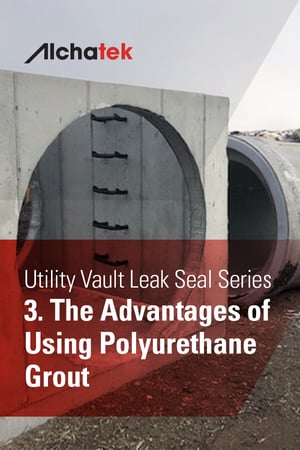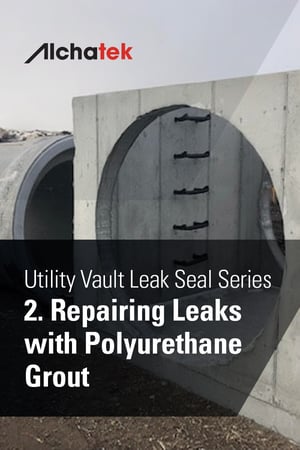
 Leak sealing in utility vaults is a critical aspect of maintaining infrastructure integrity. Various methods and materials are available for this purpose, but they are not all equal in terms of performance.
Leak sealing in utility vaults is a critical aspect of maintaining infrastructure integrity. Various methods and materials are available for this purpose, but they are not all equal in terms of performance.
Cementitious Grouts
Cementitious grouts have been a traditional choice for sealing leaks. However, they come with their own set of limitations. Cementitious grouts are rigid and thus prone to cracking over time, especially in the presence of any movement or shifting in the structure.
Polyurethane: Long-term Effectiveness
Material Longevity
One of the standout benefits of polyurethane grout is its longevity. When applied correctly, the material has a lifespan of up to 50 years. This longevity makes polyurethane grout an ideal choice for applications where long-term performance is critical.
Flexibility After Curing
Unlike cementitious grouts, which are rigid and can crack over time, flexible polyurethane grouts remain flexible even after they have cured. This characteristic is essential in structures that may experience slight shifts over time or undergo freeze/thaw cycles. The flexibility of polyurethane grout accommodates these movements, reducing the likelihood of cracks and subsequent leaks.
Polyurethane: Economic Efficiency
The durability of the polyurethane grout means fewer if any, reapplications are needed over time. Additionally, its quick-setting nature often results in reduced labor costs, making it a cost-effective choice in the long run.
Environmental Considerations
The use of polyurethane repair grouts that meet NSF/ANSI/CAN 61 standards is crucial for any project that involves materials coming into contact with drinking water or where environmental safety is a concern. Administered by the National Sanitation Foundation (NSF), an independent certification organization, these standards subject products to rigorous testing and facility inspections. Adhering to these standards is essential for compliance with the Safe Drinking Water Act (SDWA), a U.S. law that sets quality standards for drinking water and imposes penalties for violations. Alchatek's NSF-certified materials meet these stringent public health and safety benchmarks, undergoing regular evaluations, lab tests, and facility audits to maintain certification.
Key Takeaways
- Polyurethane grout excels in terms of material longevity and the flexibility it retains after curing.
- Economically, the long-term cost benefits of using polyurethane grout outweigh the initial higher material costs.
Environmentally, Alchatek’s NSF-certified polyurethane grouts are formulated to have a minimal impact, making them a responsible choice for modern infrastructure maintenance.




 Regarding water infiltration in utility vaults, precast joints often serve as weak links. Conventional methods like cementitious grouting offer temporary solutions but often fail to withstand structural movements or shifting over time, resulting in a reoccurrence of leaks.
Regarding water infiltration in utility vaults, precast joints often serve as weak links. Conventional methods like cementitious grouting offer temporary solutions but often fail to withstand structural movements or shifting over time, resulting in a reoccurrence of leaks.
 Utility vaults are critical components of modern infrastructure, providing secure containment for electrical, telecommunications, or other equipment. They are designed to be robust and durable. However, one common but often overlooked issue is the occurrence of leaks, most commonly found in precast joints and pipe penetrations.
Utility vaults are critical components of modern infrastructure, providing secure containment for electrical, telecommunications, or other equipment. They are designed to be robust and durable. However, one common but often overlooked issue is the occurrence of leaks, most commonly found in precast joints and pipe penetrations.
 Uneven concrete slabs raise risks for retail establishments during crowded holiday shopping seasons. Unlevel concrete can easily cause tripping accidents, injuries, lawsuits, and disruptions. To mitigate these issues, retail owners need to address slab problems proactively before the holiday rush. Durable polyurethane concrete leveling is an optimal solution for lifting, stabilizing, and filling voids in sunken concrete.
Uneven concrete slabs raise risks for retail establishments during crowded holiday shopping seasons. Unlevel concrete can easily cause tripping accidents, injuries, lawsuits, and disruptions. To mitigate these issues, retail owners need to address slab problems proactively before the holiday rush. Durable polyurethane concrete leveling is an optimal solution for lifting, stabilizing, and filling voids in sunken concrete.

 Collaborating with skilled contractors is key to developing effective slab repair plans and ensuring customer safety. The partnership involves assessing slab and soil conditions to identify appropriate solutions like lifting, stabilization, or void-filling. Timing repairs to minimize business disruptions also requires collaboration.
Collaborating with skilled contractors is key to developing effective slab repair plans and ensuring customer safety. The partnership involves assessing slab and soil conditions to identify appropriate solutions like lifting, stabilization, or void-filling. Timing repairs to minimize business disruptions also requires collaboration.
 The holiday season is almost upon us, and as a retail establishment owner or manager, you're likely gearing up for the rush of customers that this festive time brings. Amidst the excitement and anticipation, it's crucial not to overlook a key aspect of ensuring a successful and safe holiday season: addressing sunken and unlevel slabs on your property.
The holiday season is almost upon us, and as a retail establishment owner or manager, you're likely gearing up for the rush of customers that this festive time brings. Amidst the excitement and anticipation, it's crucial not to overlook a key aspect of ensuring a successful and safe holiday season: addressing sunken and unlevel slabs on your property.
 Concrete Leveling with Polyurethane
Concrete Leveling with Polyurethane
 As the holiday season approaches, the air becomes crisp with excitement, and retail establishments prepare for a surge in customer traffic. The festive spirit fills the air, but it also brings with it a set of unique challenges, particularly when it comes to maintaining safety and stability on your property.
As the holiday season approaches, the air becomes crisp with excitement, and retail establishments prepare for a surge in customer traffic. The festive spirit fills the air, but it also brings with it a set of unique challenges, particularly when it comes to maintaining safety and stability on your property.
 If you own or manage a below-grade parking garage, contact Alchatek for more information about protecting your property from water damage. Our team can provide insights and recommendations tailored to your facility's unique waterproofing needs.
If you own or manage a below-grade parking garage, contact Alchatek for more information about protecting your property from water damage. Our team can provide insights and recommendations tailored to your facility's unique waterproofing needs.
 Below-grade parking garages are susceptible to moisture due to their subterranean nature. This moisture can pose significant risks to the electrical systems within these structures. Water leakage around electrical conduits can lead to short circuits, electrical fires, and even electrocution hazards. These risks not only endanger lives but can also result in substantial legal liabilities for garage managers.
Below-grade parking garages are susceptible to moisture due to their subterranean nature. This moisture can pose significant risks to the electrical systems within these structures. Water leakage around electrical conduits can lead to short circuits, electrical fires, and even electrocution hazards. These risks not only endanger lives but can also result in substantial legal liabilities for garage managers.